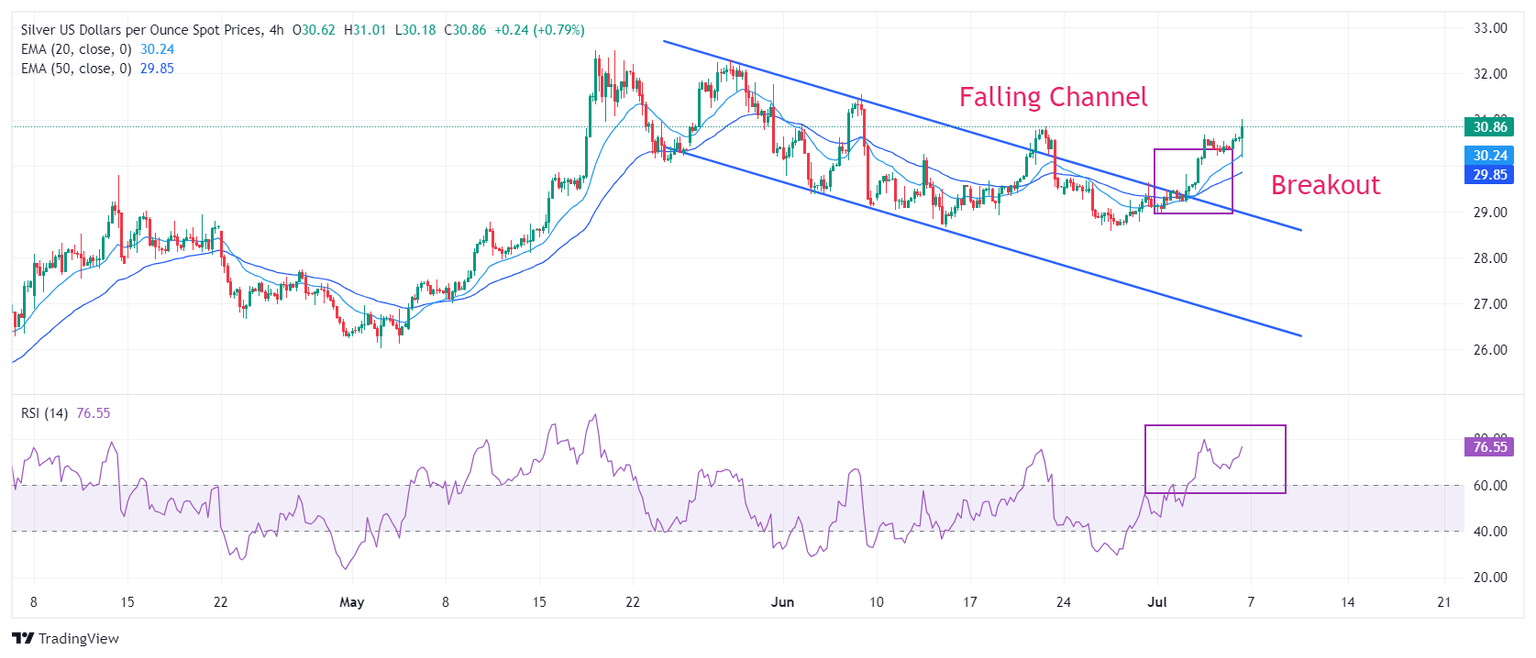Silver Price Forecast: XAG/USD rallies to $31 as US labor market strength eases in June
- Silver price jumps to near $31.00 as US yields decline after weak US NFP report.
- The payrolls data beats estimate but remain below May’s reading.
- Silver price strengthens after a Falling Channel breakout.

Silver price (XAG/USD) posts a fresh three-week high near $31.00 in Friday’s American session. The white metal strengthens as US bond yields weaken after the United States (US) Nonfarm Payrolls (NFP) report for June showed that the labor market lost momentum.
The Unemployment Rate rose to 4.1% from the estimates and the prior release of 4.0%. The number of individuals hired by employers came in higher at 206K from estimates of 190K but lower than the prior release of 218K, downwardly revised from 272K.
Also, Average Hourly Earnings declined expectedly in June. On month and annual basis, Average Hourly Earnings grew at a slower pace of 0.3% and 3.9%, respectively.
Soft wage data, downwardly revised payrolls and further rise in the jobless rate suggests that strength in the labor market conditions has eased further. This would boost expectations of early rate cuts by the Federal Reserve (Fed). Currently, market participants expect that the Fed will start reducing interest rates from September.
10-year US Treasury yields fall to near 4.3%. A decline in yields on interest-bearing assets reduces the opportunity cost of holding an investment in non-yielding assets, such as Silver.
The US Dollar Index (DXY), which tracks the Greenback’s value against six major currencies, remains in the bearish trajectory around 105.00.
Silver technical analysis
Silver price strengthens after a breakout of the Falling Channel formation on a four-hour timeframe. An upside break of the above-mentioned chart pattern results in a bullish reversal. A bull cross, represented by 20-and 50-day Exponential Moving Averages (EMAs) at $29.30, exhibits a bullish trend.
The 14-period Relative Strength Index (RSI) shifts into the bullish range of 60.00-80.00, indicating that momentum has shifted to the upside.
Silver four-hour chart
Silver FAQs
Silver is a precious metal highly traded among investors. It has been historically used as a store of value and a medium of exchange. Although less popular than Gold, traders may turn to Silver to diversify their investment portfolio, for its intrinsic value or as a potential hedge during high-inflation periods. Investors can buy physical Silver, in coins or in bars, or trade it through vehicles such as Exchange Traded Funds, which track its price on international markets.
Silver prices can move due to a wide range of factors. Geopolitical instability or fears of a deep recession can make Silver price escalate due to its safe-haven status, although to a lesser extent than Gold's. As a yieldless asset, Silver tends to rise with lower interest rates. Its moves also depend on how the US Dollar (USD) behaves as the asset is priced in dollars (XAG/USD). A strong Dollar tends to keep the price of Silver at bay, whereas a weaker Dollar is likely to propel prices up. Other factors such as investment demand, mining supply – Silver is much more abundant than Gold – and recycling rates can also affect prices.
Silver is widely used in industry, particularly in sectors such as electronics or solar energy, as it has one of the highest electric conductivity of all metals – more than Copper and Gold. A surge in demand can increase prices, while a decline tends to lower them. Dynamics in the US, Chinese and Indian economies can also contribute to price swings: for the US and particularly China, their big industrial sectors use Silver in various processes; in India, consumers’ demand for the precious metal for jewellery also plays a key role in setting prices.
Silver prices tend to follow Gold's moves. When Gold prices rise, Silver typically follows suit, as their status as safe-haven assets is similar. The Gold/Silver ratio, which shows the number of ounces of Silver needed to equal the value of one ounce of Gold, may help to determine the relative valuation between both metals. Some investors may consider a high ratio as an indicator that Silver is undervalued, or Gold is overvalued. On the contrary, a low ratio might suggest that Gold is undervalued relative to Silver.
Author

Sagar Dua
FXStreet
Sagar Dua is associated with the financial markets from his college days. Along with pursuing post-graduation in Commerce in 2014, he started his markets training with chart analysis.


















